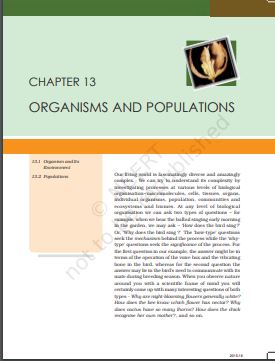Organisms And Populations PDF Free Download

Organisms and Populations
13.1 Organism And Its Environment
Ecology at the organismic level is essentially physiological ecology which tries to understand how different organisms are adapted to their environments in terms of not only survival but also reproduction.
You may have learned in earlier classes how the rotation of our planet around the Sun and the tilt of its axis cause annual variations in the intensity and duration of the temperature, resulting in distinct seasons.
These variations together with annual variation in precipitation (remember precipitation includes both rain and snow) account for the formation of major biomes such as deserts, rain forests,s and tundra (Figure 13.1).
Regional and local variations within each biome lead to the formation of a wide variety of habitats. Major biomes of India are shown in Figure 13.2.
On planet Earth, life exists not just in a few favorable habitats but even in extreme and harsh habitats – scorching Rajasthan desert, perpetually rain-soaked Meghalaya forests, deep ocean trenches, torrential streams, permafrost polar regions, high mountain tops, boiling thermal springs, and stinking compost pits, to name a few.
Even our intestine is a unique habitat for hundreds of species of microbes.
What are the key elements that lead to so much variation in the physical and chemical conditions of different habitats?
The most important ones are temperature, water, light, and soil.
We must remember that the Physico-chemical (abiotic) components alone do not characterize the habitat of an organism completely; the habitat includes biotic components also – pathogens, parasites, predators, and competitors – of the organism with which they interact constantly.
We assume that over a period of time, the organism had through natural selection, evolved adaptations to optimize its survival and reproduction in its habitat.
| Author | – |
| Language | English |
| No. of Pages | 24 |
| PDF Size | 667 KB |
| Category | Biology |
| Source/Credits | – |
Organisms and Populations PDF Free Download
